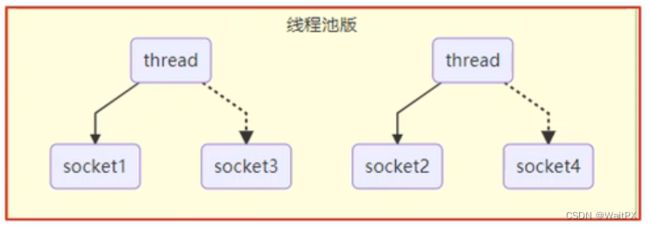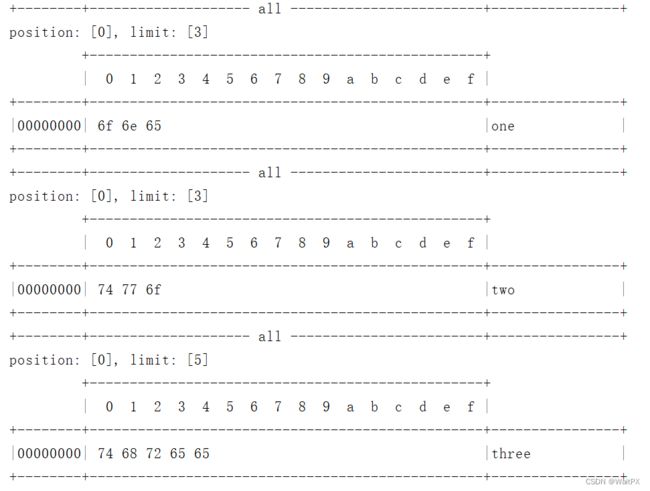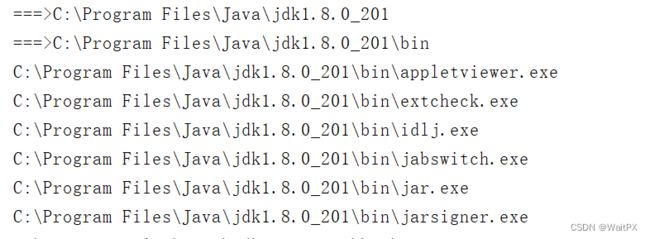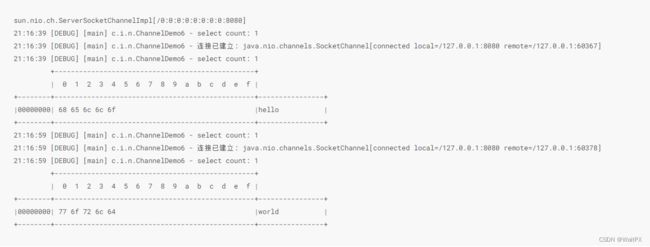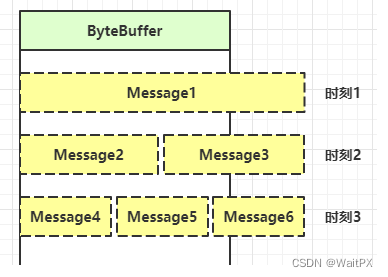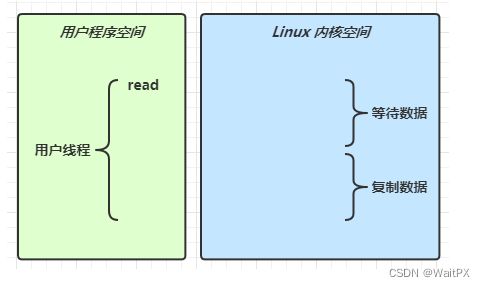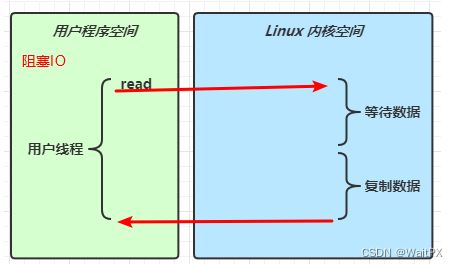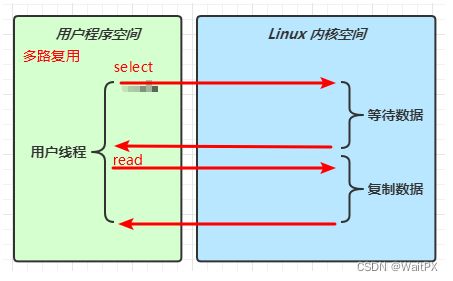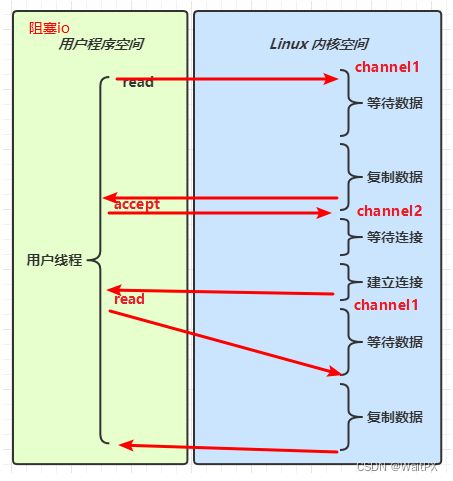NIO基础
NIO基础
1.三大组件
1.1 Channel & Buffer
Channel有一点类似于stream,它就是读写数据的双向通道,可以从channel将数据读入buffer,也可以将buffer的数据写入channel,而之前的stream要么是输入,要么是输出,channel比stream更为底层。
常见的Channel有
- FileChannel:用于文件的数据传输通道
- DatagramChannel:用于UDP时数据传输通道
- SocketChannel:用于TCP时数据传输通道,客户端服务器皆可
- ServerSocketChannel:用于TCP时数据传输通道,服务器
buffer则用于缓冲读写数据,常见的buffer有
- ByteBuffer
- MappedByteBuffer
- DirectByteBuffer
- HeapByteBuffer
- ShortBuffer
- IntBuffer
- LongBuffer
- FloatBuffer
- DoubleBuffer
- CharBuffer
1.2 Selector
selector单从字面意思不好理解,需要结合服务器的设计演化来理解它的用途
多线程版设计
- 内存占用高
- 线程上下文切换成本高
- 只适合连接数少的场景
线程池版设计
- 阻塞模式下,线程仅能处理一个socket连接
- 仅适合短连接场景
selector版设计
selector的作用就是配合一个线程来管理多个channel,获取这些channel上发生的事件,这些channel工作在非阻塞模式下,不会让线程吊死在一个channel上,适合连接数特别多,但流量低的场景

调用selector的select()会阻塞直到channel发生了读写就绪事件,这些事件发生,select方法就会返回这些事件交给thread来处理
2.ByteBuffer
2.1 ByteBuffer正确使用姿势
1.向buffer写入数据,例如调用channel.read(buffer)
2.调用flip()切换至读模式
3.从buffer读取数据,例如调用buffer.get()
4.调用clear()或compact()切换至写模式
5.重复1~4步骤
代码:
@Slf4j
public class TestByteBuffer {
public static void main(String[] args) {
try {
//FileChannel
FileChannel channel = new FileInputStream("data.txt").getChannel();
//准备缓冲区
ByteBuffer buffer = ByteBuffer.allocate(10);
//从FileChannel读取数据,向buffer写入
while(true){
int len = channel.read(buffer);
log.debug("读取到的字节数 {}",len);
if(len == -1){ //没有内容
break;
}
//打印buffer的内容
buffer.flip(); //切换至读模式
while (buffer.hasRemaining()) { //是否还有剩余未读数据
byte b = buffer.get();
log.debug("实际字节 {}",(char) b);
}
buffer.clear(); //切换为写模式
}
} catch (IOException e) {
e.printStackTrace();
}
}
}
2.2 ByteBuffer结构
ByteBuffer有以下重要属性
- capacity:总容量
- position:读写指针
- limit:读写限制
一开始

写模式下,position是写入位置,limit等于容量,下图表示写入了4个字节后的状态

flip(读)动作发生后,position切换为读取位置,limit切换为读取限制
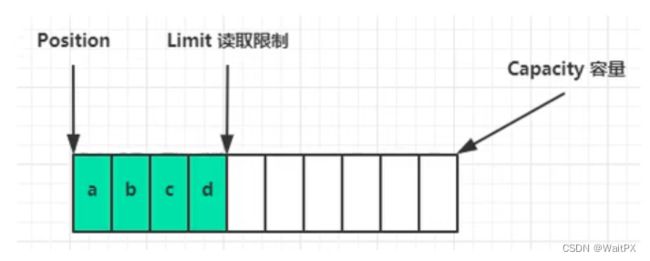
读取4个字节后,状态
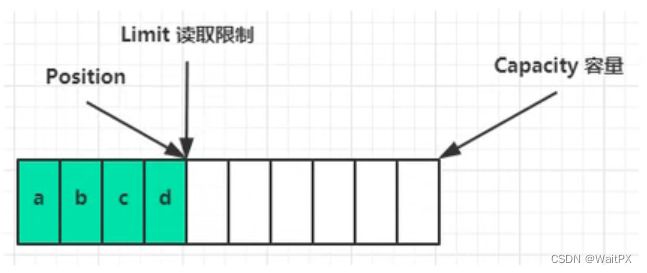
clear(写)动作发生后,状态

compact方法,是把未读完的部分向前压缩,然后切换至写模式

2.3 ByteBuffer常见方法
分配空间
可以使用allocate或者allocateDirect方法为ByteBuffer分配空间,其他buffer类也有该方法
Bytebuffer buf = ByteBuffer.allocate(16);
Bytebuffer buf = ByteBuffer.allocateDirect(16)
区别:
class java.nio.HeapByteBuffer:java堆内存,读写效率较低,受到GC的影响。
class java.nio.DirectByteBuffer:直接内存,读写效率高(少一次拷贝),不会受到GC影响,分配的效率低。
向buffer写入数据
有两种方法
- 调用channel的read方法
- 调用buffer自己的put方法
int readBytes = channel.read(buf);
和
buf.put((byte)127);
从buffer读取数据
同样有两种方法
- 调用channel的write方法
- 调用buffer自己的get方法
int writeBytes = channel.write(buf);
和
byte b = buf.get();
get方法会让position读指针向后走,如果想重复读取数据
- 可以调用rewind方法将position重新置为0
- 或者调用get(int i)方法获取索引i的内容,它不会移动读指针
rewind:
ByteBuffer buffer = ByteBuffer.allocate(10);
buffer.put(new byte[]{'a','b','c','d'});
buffer.flip();
//rewind从头开始读
buffer.get(new byte[4]);
debugAll(buffer);
buffer.rewind();
debugAll(buffer);
System.out.println((char) buffer.get());
System.out.println((char) buffer.get());
buffer.mark(); //加标记,索引2的位置
System.out.println((char) buffer.get());
System.out.println((char) buffer.get());
buffer.reset(); //是将position重置到索引2
System.out.println((char) buffer.get());
System.out.println((char) buffer.get());
System.out.println((char) buffer.get(3));
debugAll(buffer);
字符串与ByteBuffer互转
代码:
//1.字符串转为ByteBuffer
ByteBuffer buffer1 = ByteBuffer.allocate(16);
buffer1.put("hello".getBytes());
debugAll(buffer1);
//2.Charset
ByteBuffer buffer2 = Charset.forName("UTF-8").encode("hello");
debugAll(buffer2);
//3.wrap
ByteBuffer buffer3 = ByteBuffer.wrap("hello".getBytes());
debugAll(buffer3);
//4.转为字符串
String str1 = Charset.forName("UTF-8").decode(buffer2).toString();
System.out.println(str1);
buffer1.flip();
String str2 = Charset.forName("UTF-8").decode(buffer1).toString();
System.out.println(str2);
2.4 Scattering Reads
分散读取,有一个文本文件words.txt
onetwothree
使用如下方式读取,可以将数据填充至多个buffer
try {
FileChannel channel = new RandomAccessFile("words.txt", "r").getChannel();
ByteBuffer b1 = ByteBuffer.allocate(3);
ByteBuffer b2 = ByteBuffer.allocate(3);
ByteBuffer b3 = ByteBuffer.allocate(5);
channel.read(new ByteBuffer[]{b1,b2,b3});
b1.flip();
b2.flip();
b3.flip();
debugAll(b1);
debugAll(b2);
debugAll(b3);
} catch (IOException e) {
e.printStackTrace();
}
2.5 Gathering Writes
使用如下方式写入,可以将多个buffer中的数据写入到一个文件
ByteBuffer b1 = Charset.forName("UTF-8").encode("hello");
ByteBuffer b2 = Charset.forName("UTF-8").encode("world");
ByteBuffer b3 = Charset.forName("UTF-8").encode("您好");
try {
FileChannel channel = new RandomAccessFile("words2.txt", "rw").getChannel();
channel.write(new ByteBuffer[]{b1,b2,b3});
} catch (IOException e) {
e.printStackTrace();
}
2.6 练习
题目:网络上有多条数据发送给服务端,数据之间使用\n进行分割,但由于某种原因这些数据在接收时,被进行了重新组合,例如原始数据有3条为
Hello,world\n
I’m zhangsan\n
How are you?\n
变成了下面的两个byteBuffer(黏包,半包)
Hello,world\nI’m zhangsan\nHo
w are you?\n
现在要求你编写程序,将错乱的数据恢复成原始的按\n分割的数据
public static void main(String[] args) {
ByteBuffer source = ByteBuffer.allocate(32);
source.put("Hello,world\nI'm zhangsan\nHo".getBytes());
split(source);
source.put("w are you?\n".getBytes());
split(source);
}
private static void split(ByteBuffer source){
source.flip();
for(int i=0;i<source.limit();i++){
//找到一条完整消息
if(source.get(i)=='\n'){
int len = i + 1 - source.position();
//把这条完整信息存入新的ByteBuffer
ByteBuffer target = ByteBuffer.allocate(len);
for(int j = 0; j < len; j++){
target.put(source.get());
}
debugAll(target);
}
}
source.compact();
}
3.文件编程
3.1 FileChannel
注意
FileChannel只能工作在阻塞模式下
获取
不能直接打开FileChannel,必须通过FileInputStream、FileOutputStream或者RandomAccessFile来获取FileChannel,它们都有getChannel方法
- 通过FileInputStream获取的channel只能读
- 通过FileOutputStream获取的channel只能写
- 通过RandomAccessFile是否能读写根据构造RandomAccessFile时的读写模式决定
读取
会从channel读取数据填充ByteBuffer,返回值表示读到了多少字节,-1表示到达了文件的末尾
int readBytes = channel.read(buffer);
写入
写入的正确姿势如下,
ByteBuffer buffer = ...;
buffer.put(...);
buffer.flip(); //切换读模式
while(buffer.hasRemaining()){
channel.write(buffer);
}
在while中调用channel.write是因为write方法并不能保证一次将buffer中的内容全部写入channel
关闭
channel必须关闭,不过调用了FileInputStream、FileOuputStream或者RandomAccessFile的close方法会间接地调用channel的close方法
位置
获取当前位置
long pos = channel.position();
设置当前位置
long newPos = ...;
channel.position(newPos);
设置当前位置时,如果设置为文件的末尾
- 这时读取会返回-1
- 这时写入,会追加内容,但要注意如果position超过了文件末尾,再写入时在新内容和原末尾之间会有空洞(00)
大小
使用size方法获取文件的大小
强制写入
操作系统出于性能的考虑,会将数据缓存,不是立刻写入磁盘。可以调用force(true)方法将文件内容和元数据(文件的权限等信息)立刻写入磁盘。
3.2 两个Channel传输数据
try {
FileChannel from = new FileInputStream("data.txt").getChannel();
FileChannel to = new FileOutputStream("to.txt").getChannel();
//效率高,底层会利用操作系统的零拷贝优化,2g数据
long size = from.size();
for (long left = size;left >0;) {
left -= from.transferTo(size-left,left,to);
}
from.close();
to.close();
} catch (IOException e) {
e.printStackTrace();
}
3.3 Path
jdk7引入了Path和Paths类
- Path用来表示文件路径
- Paths是工具类,用来获取Path实例
Path source = Paths.get("1.txt"); //相对路径,使用user.dir环境变量来定位1.txt
Path source = Paths.get("d://1.txt"); //绝对路径,代表了d:\1.txt
Path source = Paths.get("d:/1.txt"); //绝对路径,代表了d:\1.txt
Path source = Paths.get("d://data","projects"); //代表了d:\data\projects
- .代表了当前路径
- . .代表了上一级路径
代码
Path path = Paths.get("d:\\data\\projects\\a\\..\\b");
System.out.println(path);
System.out.println(path.normalize); //正常化路径
会输出
d:\data\projects\a\..\b
d:\data\projects\b
3.4 Files
检查文件是否存在
Path path = Paths.get("to.txt");
System.out.println(Files.exists(path));
创建一级目录
Path path = Paths.get("d1");
Files.createDirectory(path);
- 如果目录已存在,会抛出FileAlreadExistsException
- 不能一次创建多级目录,否则会抛异常NoSuchFileException
创建多级目录
Path path = Paths.get("d1/d2");
Files.createDirectories(path);
拷贝文件
Path source = Paths.get("helloword/data.txt");
Path target= Paths.get("helloword/target.txt");
Files.copy(source,target);
- 如果文件已存在,会抛出FileAlreadExistsException
如果希望用source覆盖掉target,需要用StandardCopyOption来控制
Files.copy(source,target,StandardCopyOption.REPLACE_EXISTING);
移动文件
Path source = Paths.get("helloword/data.txt");
Path target= Paths.get("helloword/target.txt");
Files.move(source,target,StandardCopyOption.ATOMIC_MOVE);
- StandardCopyOption.ATOMIC_MOVE保证文件移动的原子性
删除文件
Path target= Paths.get("helloword/target.txt");
Files.delete(target);
- 如果文件不存在,会抛异常NoSuchFileException
删除目录
Path target= Paths.get("helloword/d1");
Files.delete(target);
- 如果目录还有内容,会抛异常DirectoryNotEmptyException
walkfiletree-遍历
代码:
AtomicInteger dirCount = new AtomicInteger(); //不能使用int变量,匿名内部类必须使用final修饰的变量,否则会产生二义性
AtomicInteger fileCount = new AtomicInteger();
Files.walkFileTree(Paths.get("C:\\Program Files\\Java\\jdk1.8.0_201"),new SimpleFileVisitor<Path>(){
//访问文件夹前
@Override
public FileVisitResult preVisitDirectory(Path dir, BasicFileAttributes attrs) throws IOException {
System.out.println("===>"+dir);
dirCount.getAndIncrement();
return super.preVisitDirectory(dir, attrs);
}
//访问文件夹后
@Override
public FileVisitResult postVisitDirectory(Path dir, IOException exc) throws IOException {
return super.postVisitDirectory(dir, exc);
}
//访问文件
@Override
public FileVisitResult visitFile(Path file, BasicFileAttributes attrs) throws IOException {
System.out.println(file);
fileCount.getAndIncrement();
return super.visitFile(file, attrs);
}
//访问文件失败
@Override
public FileVisitResult visitFileFailed(Path file, IOException exc) throws IOException {
return super.visitFileFailed(file, exc);
}
});
System.out.println("文件夹的个数:"+dirCount);
System.out.println("文件的个数:"+fileCount);
walkfiletree-删除多级目录
代码:
Files.walkFileTree(Paths.get("C:\\Program Files\\Java\\jdk1.8.0_201"),new SimpleFileVisitor<Path>(){
//访问文件夹前
@Override
public FileVisitResult preVisitDirectory(Path dir, BasicFileAttributes attrs) throws IOException {
return super.preVisitDirectory(dir, attrs);
}
//访问文件夹后
@Override
public FileVisitResult postVisitDirectory(Path dir, IOException exc) throws IOException {
Files.delete(dir);
return super.postVisitDirectory(dir, exc);
}
//访问文件
@Override
public FileVisitResult visitFile(Path file, BasicFileAttributes attrs) throws IOException {
Files.delete(file);
return super.visitFile(file, attrs);
}
//访问文件失败
@Override
public FileVisitResult visitFileFailed(Path file, IOException exc) throws IOException {
return super.visitFileFailed(file, exc);
}
});
walk-拷贝多级目录
代码:
String source = "C:\\Users\\19088\\Desktop\\spring-security-master";
String target = "C:\\Users\\19088\\Desktop\\spring-security-master11";
Files.walk(Paths.get(source)).forEach(path -> {
try {
String targetName = path.toString().replace(source,target);
//是目录
if(Files.isDirectory(path)){
Files.createDirectory(Paths.get(targetName));
}
//是文件
if(Files.isRegularFile(path)){
Files.copy(path,Paths.get(targetName));
}
} catch (IOException e) {
e.printStackTrace();
}
});
4.网络编程
4.1 非阻塞 VS 阻塞
阻塞
- 阻塞模式下,相关方法都会导致线程暂停
- ServerSocketChannel.accept会在没有连接建立时让线程暂停
- SocketChannel.read会在没有数据可读时让线程暂停
- 阻塞的表现其实就是线程暂停了,暂停期间不会占用cpu,但线程相当于闲置
- 单线程下,阻塞方法之间相互影响,几乎不能正常工作,需要多线程支持
- 但多线程下,有新的问题,体现在以下方面
- 32位jvm一个线程320k,64位jvm一个线程1024k,如果连接数过多,必然导致OOM,并且线程太多,反而会因为频繁上下文切换导致性能降低
- 可以使用线程池技术来减少线程数和上下文切换,但治标不治本,如果有很多连接建立,但长时间inactive,会阻塞线程池中所有线程,因此不适合长连接,只适合短连接。
服务器端:
//使用nio来理解阻塞模式,单线程
//0.ByteBuffer
ByteBuffer buffer = ByteBuffer.allocate(16);
//1.创建了服务器
ServerSocketChannel ssc = ServerSocketChannel.open();
//2.绑定监听端口
ssc.bind(new InetSocketAddress(8080));
//3.连接集合
List<SocketChannel> channels = new ArrayList<>();
while(true){
//4.accpet建立与客户端连接,SocketChannel用来与客户端通信
log.debug("connecting...");
SocketChannel sc = ssc.accept(); //阻塞方法,线程停止运行
log.debug("connected... {}",sc);
channels.add(sc);
for (SocketChannel channel: channels) {
//5.接收客户端发送的数据
log.debug("before read... {}",channel);
channel.read(buffer); //阻塞方法,线程停止运行
buffer.flip();
debugRead(buffer);
buffer.clear();
log.debug("after read... {}",channel);
}
}
客户端:
SocketChannel sc = SocketChannel.open();
sc.connect(new InetSocketAddress("localhost",8080));
System.out.println("waiting...");
非阻塞
- 非阻塞模式下,相关方法都会不会让线程暂停
- 在ServerSocketChannel.accept在没有连接建立时,会返回null,继续运行
- SocketChannel.read在没有数据可读时,会返回0,但线程不必阻塞,可以去执行其他SocketChannel的read或是去执行ServerSocketChannel.accept
- 写数据时,线程只是等待数据写入Channel即可,无需等Channel通过网络把数据发送出去
- 但非阻塞模式下,即使没有连接建立,和可读数据,线程仍然在不断运行,白白浪费了cpu
- 数据复制过程中,线程实际还是阻塞的(AIO改进的地方)
服务器端,客户端代码不变
//使用nio来理解非阻塞模式,单线程
//0.ByteBuffer
ByteBuffer buffer = ByteBuffer.allocate(16);
//1.创建了服务器
ServerSocketChannel ssc = ServerSocketChannel.open();
ssc.configureBlocking(false); //非阻塞模式
//2.绑定监听端口
ssc.bind(new InetSocketAddress(8080));
//3.连接集合
List<SocketChannel> channels = new ArrayList<>();
while(true){
//4.accpet建立与客户端连接,SocketChannel用来与客户端通信
SocketChannel sc = ssc.accept(); //非阻塞,线程还会继续运行,如果没有连接建立,但sc是null
if(sc != null) {
log.debug("connected... {}", sc);
sc.configureBlocking(false); //非阻塞方法
channels.add(sc);
}
for (SocketChannel channel: channels) {
//5.接收客户端发送的数据
int read = channel.read(buffer); //非阻塞,线程仍然会继续运行,如果没有读到数据,read返回0
if(read > 0) {
buffer.flip();
debugRead(buffer);
buffer.clear();
log.debug("after read... {}", channel);
}
}
}
多路复用
单线程可以配合Selector完成对多个Channel可读写事件的监控,这称之为多路复用
- 多路复用仅针对网络IO、普通文件IO没法利用多路复用
- 如果不用Selector的非阻塞模式,线程大部分时间都在做无用功,而Selector能够保证
- 有可连接事件时才去连接
- 有可读事件才去读取
- 有可写事件才去写入
- 限于网络传输能力,Channel未必时时可写,一旦Channel可写,会触发Selector的可写事件
4.2 Selector
好处
- 一个线程配合selector就可以监控多个channel事件,事件发生线程才会去处理。避免非阻塞模式下做无用功
- 让这个线程能够充分利用
- 节约了线程的数量
- 减少了线程上下文切换
创建
Selector selector = Selector.open();
绑定Channel事件
也称之为注册事件,绑定的事件selector才会关心
channel.configureBlocking(false);
SelectionKey key = channel.register(selector,绑定事件);
- channel必须工作在非阻塞模式
- FileChannel没有非阻塞模式,因此不能配合selector一起使用
- 绑定的事件类型可以有
- connect -客户端连接成功时触发
- accept -服务器端成功接受连接时触发
- read -数据可读入时触发,又因为接受能力弱,数据暂不能读入的情况
- write -数据可写出时触发,又因为发送能力弱,数据暂不能写出的情况
监听Channel事件
可以通过下面三种方法来监听是否有事件发生,方法的返回值代表有多少channel发生了事件
方法1,阻塞直到绑定事件发生
int count = selector.select();
方法2,阻塞直到绑定事件发生,或是超时(时间单位为ms)
int count = selector.select(long timeout);
方法3,不会阻塞,也就是不管有没有事件,立刻返回,自己根据返回值检查是否有事件
int count = selector.selectNow();
select何时不阻塞
- 事件发生时
- 客户端发起连接请求,会触发accept事件
- 客户端发送数据过来,客户端正常、异常关闭时,都会触发read事件,另外如果发送的数据大于buffer缓冲区,会触发多次读取事件
- channel可写,会触发write事件
- 在linux下nio bug发生时
- 调用selector.wakeup()
- 调用selector.close()
- selector所在线程interrupt
4.3 处理accept事件
客户端代码为
SocketChannel sc = SocketChannel.open();
sc.connect(new InetSocketAddress("localhost",8080));
System.out.println("waiting...");
在dubug模式开启即可
服务器端代码为
@Slf4j
public class ChannelDemo6 {
public static void main(String[] args) {
try (ServerSocketChannel channel = ServerSocketChannel.open()) {
channel.bind(new InetSocketAddress(8080));
System.out.println(channel);
Selector selector = Selector.open();
channel.configureBlocking(false);
channel.register(selector, SelectionKey.OP_ACCEPT);
while (true) {
int count = selector.select();
log.debug("select count: {}", count);
// 获取所有事件
Set<SelectionKey> keys = selector.selectedKeys();
// 遍历所有事件,逐一处理
Iterator<SelectionKey> iter = keys.iterator();
while (iter.hasNext()) {
SelectionKey key = iter.next();
// 判断事件类型
if (key.isAcceptable()) {
ServerSocketChannel c = (ServerSocketChannel) key.channel();
// 必须处理
SocketChannel sc = c.accept();
log.debug("{}", sc);
}
// 处理完毕,必须将事件移除
iter.remove();
}
}
} catch (IOException e) {
e.printStackTrace();
}
}
}
事件发生后能否不处理
事件发生后,要么处理,要么取消(cancel),不能什么都不做,否则下次该事件仍会触发,这是因为nio底层使用的是水平触发
4.4 处理read事件
@Slf4j
public class Server {
public static void main(String[] args) throws IOException {
//1.创建selector,管理多个channel
Selector selector = Selector.open();
ServerSocketChannel ssc = ServerSocketChannel.open();
ssc.configureBlocking(false);
//2.建立selector和channel的联系(注册)
//SelectionKey就是将来事件发生后,通过它可以知道事件和哪个channel的事件
SelectionKey sscKey = ssc.register(selector, 0, null);
//key只关注accept事件
sscKey.interestOps(SelectionKey.OP_ACCEPT);
log.debug("register key:{}",sscKey);
ssc.bind(new InetSocketAddress(8080));
while(true){
//3.select方法,没有事件发生,线程阻塞,有事件,线程才会恢复运行
//select在事件未处理时,它不会阻塞,事件发生后要么处理,要么取消(key.cancel),不能置之不理
selector.select();
//4.处理事件,selectedKeys内部包含了所有发生的事件
Iterator<SelectionKey> iter = selector.selectedKeys().iterator(); //accept,read
while(iter.hasNext()){
SelectionKey key = iter.next();
//处理key的时候,要从selectedKeys集合中删除,否则下次处理就会有问题
iter.remove();
log.debug("key:{}",key);
//5.区分事件类型
if (key.isAcceptable()) { //如果是accept
ServerSocketChannel channel = (ServerSocketChannel)key.channel();
SocketChannel sc = channel.accept();
sc.configureBlocking(false);
SelectionKey sckey = sc.register(selector, 0, null);
sckey.interestOps(SelectionKey.OP_READ);
log.debug("{}",sc);
}else if(key.isReadable()){ //如果是read
try {
SocketChannel channel = (SocketChannel) key.channel();
ByteBuffer buffer = ByteBuffer.allocate(4);
int read = channel.read(buffer); //如果是正常断开,read的方法的返回值是-1
if(read == -1){
key.cancel();
}else{
buffer.flip();
//debugRead(buffer);
System.out.println(Charset.forName("UTF-8").decode(buffer));
}
} catch (IOException e) {
e.printStackTrace();
key.cancel(); //因为客户端断开了,因此需要将key取消(从selector的keys集合中真正删除key)
}
}
}
}
}
}
为何要iter.remove()
因为select在事件发生后,就会将相关的key放入selectedKeys集合,但不会在处理完后从selectedKeys集合中移除,需要我们自己编码删除,例如
- 第一次触发了ssckey上的accept事件,没有移除ssckey
- 第二次触发了sckey上的read事件,但这时selectedKeys中还有上次的ssckey,在处理时因为没有真正的serverSocket连上了,就会导致空指针异常
cancel的作用
cancel会取消注册在selector上的channel,并从iter集合中删除key后续不会在监听事件
不处理边界问题
服务器端代码
public class Server {
public static void main(String[] args) throws IOException {
ServerSocket ss=new ServerSocket(9000);
while (true) {
Socket s = ss.accept();
InputStream in = s.getInputStream();
// 这里这么写,有没有问题
byte[] arr = new byte[4];
while(true) {
int read = in.read(arr);
// 这里这么写,有没有问题
if(read == -1) {
break;
}
System.out.println(new String(arr, 0, read));
}
}
}
}
客户端代码
public class Client {
public static void main(String[] args) throws IOException {
Socket max = new Socket("localhost", 9000);
OutputStream out = max.getOutputStream();
out.write("hello".getBytes());
out.write("world".getBytes());
out.write("你好".getBytes());
max.close();
}
}
输出
hell
owor
ld�
�好
处理消息的边界
- 一种思路是固定消息长度,数据包大小一样,服务器按预定长度读取,缺点是浪费带宽
- 另一种思路是按分隔符拆分,缺点是效率低
- TLV格式,即Type类型、Length长度、Value数据,类型和长度已知的情况下,就可以方便获取消息大小,分配适合的buffer,缺点是buffer需要提前分配,如果内容过大,则影响server吞度量
- Http 1.1是TLV格式
- Http 2.0是LTV格式
扩容(以分隔符拆分为例):
服务器端代码
@Slf4j
public class Server {
private static void split(ByteBuffer source){
source.flip();
for(int i=0;i<source.limit();i++){
//找到一条完整消息
if(source.get(i)=='\n'){
int len = i + 1 - source.position();
//把这条完整信息存入新的ByteBuffer
ByteBuffer target = ByteBuffer.allocate(len);
for(int j = 0; j < len; j++){
target.put(source.get());
}
debugAll(target);
}
}
source.compact();
}
public static void main(String[] args) throws IOException {
//1.创建selector,管理多个channel
Selector selector = Selector.open();
ServerSocketChannel ssc = ServerSocketChannel.open();
ssc.configureBlocking(false);
//2.建立selector和channel的联系(注册)
//SelectionKey就是将来事件发生后,通过它可以知道事件和哪个channel的事件
SelectionKey sscKey = ssc.register(selector, 0, null);
//key只关注accept事件
sscKey.interestOps(SelectionKey.OP_ACCEPT);
log.debug("register key:{}",sscKey);
ssc.bind(new InetSocketAddress(8080));
while(true){
//3.select方法,没有事件发生,线程阻塞,有事件,线程才会恢复运行
//select在事件未处理时,它不会阻塞,事件发生后要么处理,要么取消(key.cancel),不能置之不理
selector.select();
//4.处理事件,selectedKeys内部包含了所有发生的事件
Iterator<SelectionKey> iter = selector.selectedKeys().iterator(); //accept,read
while(iter.hasNext()){
SelectionKey key = iter.next();
//处理key的时候,要从selectedKeys集合中删除,否则下次处理就会有问题
iter.remove();
log.debug("key:{}",key);
//5.区分事件类型
if (key.isAcceptable()) { //如果是accept
ServerSocketChannel channel = (ServerSocketChannel)key.channel();
SocketChannel sc = channel.accept();
sc.configureBlocking(false);
//将一个bytebuffer作为附件关联到selectorKey上
ByteBuffer buffer = ByteBuffer.allocate(16);
SelectionKey sckey = sc.register(selector, 0, buffer);
sckey.interestOps(SelectionKey.OP_READ);
log.debug("{}",sc);
}else if(key.isReadable()){ //如果是read
try {
SocketChannel channel = (SocketChannel) key.channel();
//获取selectionKey上关联的附件
ByteBuffer buffer = (ByteBuffer) key.attachment();
int read = channel.read(buffer); //如果是正常断开,read的方法的返回值是-1
if(read == -1){
key.cancel();
}else{
split(buffer);
if(buffer.position() == buffer.limit()){
ByteBuffer newBuffer = ByteBuffer.allocate(buffer.capacity() * 2);
buffer.flip();
newBuffer.put(buffer);
key.attach(newBuffer);
}
}
} catch (IOException e) {
e.printStackTrace();
key.cancel(); //因为客户端断开了,因此需要将key取消(从selector的keys集合中真正删除key)
}
}
}
}
}
}
客户端代码
public class Client {
public static void main(String[] args) throws IOException {
SocketChannel sc = SocketChannel.open();
sc.connect(new InetSocketAddress("localhost",8080));
SocketAddress address = sc.getLocalAddress();
sc.write(Charset.defaultCharset().encode("0123456789abcdef3333\n"));
System.in.read();
}
}
ByteBuffer大小分配
- 每个channel都需要记录可能被切分的消息,因为ByteBuffer不能被多个channel共同使用,因此需要为每个channel维护一个独立的ByteBuffer
- ByteBuffer不能太大,比如一个ByteBuffer 1Mb的话,要支持百万连接就要1Tb内存,因此需要设计大小可变的ByteBuffer
- 一种思路是首先分配一个较小的buffer,例如4k,如果发现数据不够,再分配8k的buffer,将4k buffer内容拷贝至8k buffer,优点是消息连续容易处理,缺点是数据拷贝耗费性能,参考实现http://tutorials.jenkov.com/java-performance/resizable-array.html
- 另一种思路是用多个数组组成 buffer,一个数组不够,把多出来的内容写入新的数组,与前面的区别是消息存储不连续解析复杂,优点是避免了拷贝引起的性能损耗
4.5 处理write事件
一次无法写完例子
- 非阻塞模式下,无法保证把buffer中所有的数据都写入channel,因此需要追踪write方法的返回值(代表实际写入字节数)
- 用selector监听所有channel的可写事件,每个channel都需要一个key来跟踪buffer,但这样又会导致占用内存过多,就有两阶段策略
- 当消息处理器第一次写入消息时,才将channel注册到selector上
- selector检查channel上的可写事件,如果所有的数据写完了,就取消channel的注册
- 如果不取消,每次可写均会触发write事件
服务器端代码
public class WriteServer {
public static void main(String[] args) throws IOException {
ServerSocketChannel ssc = ServerSocketChannel.open();
ssc.configureBlocking(false);
Selector selector = Selector.open();
ssc.register(selector, SelectionKey.OP_ACCEPT);
ssc.bind(new InetSocketAddress(8080));
while(true){
selector.select();
Iterator<SelectionKey> iter = selector.selectedKeys().iterator();
while (iter.hasNext()) {
SelectionKey key = iter.next();
iter.remove();
if (key.isAcceptable()) {
SocketChannel sc = ssc.accept();
sc.configureBlocking(false);
SelectionKey sckey = sc.register(selector,0,null);
sckey.interestOps(SelectionKey.OP_READ);
//1.向客户端发送大量数据
StringBuilder sb = new StringBuilder();
for (int i = 0; i < 5000000; i++) {
sb.append("a");
}
ByteBuffer buffer = Charset.defaultCharset().encode(sb.toString());
//2.返回值代表实际写入的字节数
int write = sc.write(buffer);
System.out.println(write);
//3.判断是否还有剩余内容
if(buffer.hasRemaining()){
//4.关注可写事件
sckey.interestOps(sckey.interestOps() + SelectionKey.OP_WRITE);
//5.把未写完的数据挂到sckey上
sckey.attach(buffer);
}
}else if(key.isWritable()){
ByteBuffer buffer = (ByteBuffer) key.attachment();
SocketChannel sc = (SocketChannel) key.channel();
int write = sc.write(buffer);
System.out.println(write);
//6.清理操作
if(!buffer.hasRemaining()){
key.attach(null); //需要清除buffer
key.interestOps(key.interestOps() - SelectionKey.OP_WRITE); //不需关注可写事件
}
}
}
}
}
}
客户机端代码
public class WriteClient {
public static void main(String[] args) throws IOException {
SocketChannel sc = SocketChannel.open();
sc.connect(new InetSocketAddress("localhost",8080));
//3.接收数据
int count = 0;
while(true){
ByteBuffer buffer = ByteBuffer.allocate(1024 * 1024);
count += sc.read(buffer);
System.out.println(count);
buffer.clear();
}
}
}
write为何要取消
只要向 channel 发送数据时,socket 缓冲可写,这个事件会频繁触发,因此应当只在 socket 缓冲区写下时再关注可写事件,数据写完之后再取消关注
4.6 更进一步
利用多线程优化
现在都是多核cpu,设计时要充分考虑别让cpu的力量被白白浪费
前面的代码只有一个选择器,没有充分利用多核cpu,如何改进呢?
分两组选择器
- 单线程配一个选择器,专门处理accept事件
- 创建cpu核心数的线程,每个线程配一个选择器,轮流处理read事件
服务器端代码
@Slf4j
public class MultiThreadServer {
public static void main(String[] args) throws IOException {
Thread.currentThread().setName("boss");
ServerSocketChannel ssc = ServerSocketChannel.open();
ssc.configureBlocking(false);
Selector boss = Selector.open();
SelectionKey bossKey = ssc.register(boss, 0, null);
bossKey.interestOps(SelectionKey.OP_ACCEPT);
ssc.bind(new InetSocketAddress(8080));
//1.创建固定数量的worker,并初始化
Worker[] workers = new Worker[Runtime.getRuntime().availableProcessors()];
for (int i = 0; i < workers.length; i++) {
workers[i] = new Worker("worker-" + i);
}
AtomicInteger index = new AtomicInteger();
while (true) {
boss.select();
Iterator<SelectionKey> iter = boss.selectedKeys().iterator();
while (iter.hasNext()) {
SelectionKey key = iter.next();
iter.remove();
if (key.isAcceptable()) {
SocketChannel sc = ssc.accept();
sc.configureBlocking(false);
log.debug("connected...{}", sc.getRemoteAddress());
//2.关联selector
log.debug("before register...{}", sc.getRemoteAddress());
//round robin 轮询
workers[index.getAndIncrement() % workers.length].register(sc);
log.debug("after register...{}", sc.getRemoteAddress());
}
}
}
}
static class Worker implements Runnable {
private Thread thread;
private Selector selector;
private String name;
private volatile boolean start = false; //还未初始化
private ConcurrentLinkedQueue<Runnable> queue = new ConcurrentLinkedQueue<>();
public Worker(String name) {
this.name = name;
}
//初始化线程和selector
public void register(SocketChannel sc) throws IOException {
if (!start) {
selector = Selector.open();
thread = new Thread(this, name);
thread.start();
start = true;
}
//向队列添加了任务,但这个任务并没有立刻执行 boss
queue.add(() -> {
try {
sc.register(selector, SelectionKey.OP_READ, null);
} catch (ClosedChannelException e) {
e.printStackTrace();
}
});
selector.wakeup(); //唤醒select方法
}
@Override
public void run() {
while (true) {
try {
selector.select(); //worker-0 阻塞 wakeup
Runnable task = queue.poll();
if (task != null) {
task.run(); //执行了sc.register(selector,SelectionKey.OP_READ,null);
}
Iterator<SelectionKey> iter = selector.selectedKeys().iterator();
while (iter.hasNext()) {
SelectionKey key = iter.next();
iter.remove();
if (key.isReadable()) {
ByteBuffer buffer = ByteBuffer.allocate(16);
SocketChannel channel = (SocketChannel) key.channel();
log.debug("read...{}", channel.getRemoteAddress());
channel.read(buffer);
buffer.flip();
debugAll(buffer);
}
}
} catch (IOException e) {
e.printStackTrace();
}
}
}
}
}
客户端代码
public class TestClient {
public static void main(String[] args) throws IOException {
SocketChannel sc = SocketChannel.open();
sc.connect(new InetSocketAddress("localhost",8080));
sc.write(Charset.defaultCharset().encode("1234567890abcef"));
System.in.read();
}
}
如何拿到cpu个数
- Runtime.getRuntime().availableProcessors()如果工作在docker下,因为容器不是物理隔离的,会拿到物理cpu个数,而不是容器申请时的个数
- 这个问题知道jdk 10才修复,使用jvm参数UseContainerSupport配置,默认开启
4.7 UDP
- UDP 是无连接的,client 发送数据不会管 server 是否开启
- server 这边的 receive 方法会将接收到的数据存入 byte buffer,但如果数据报文超过 buffer 大小,多出来的数据会被默默抛弃
首先启动服务器端
public class UdpServer {
public static void main(String[] args) {
try (DatagramChannel channel = DatagramChannel.open()) {
channel.socket().bind(new InetSocketAddress(9999));
System.out.println("waiting...");
ByteBuffer buffer = ByteBuffer.allocate(32);
channel.receive(buffer);
buffer.flip();
debug(buffer);
} catch (IOException e) {
e.printStackTrace();
}
}
}
输出
waiting...
运行客户端
public class UdpClient {
public static void main(String[] args) {
try (DatagramChannel channel = DatagramChannel.open()) {
ByteBuffer buffer = StandardCharsets.UTF_8.encode("hello");
InetSocketAddress address = new InetSocketAddress("localhost", 9999);
channel.send(buffer, address);
} catch (Exception e) {
e.printStackTrace();
}
}
}
5.NIO vs BIO
5.1 stream vs channel
- stream不会自动缓冲数据,channel会利用系统提供的发送缓冲区、接收缓冲区(更为底层)
- stream仅支持阻塞API,channel同时支持阻塞、非阻塞API,网络channel可配合selector实现多路复用
- 二者均为全双工,即读写可以同时进行
5.2 IO模型
同步阻塞、同步非阻塞、同步多路复用、异步阻塞(没有此情况)、异步非阻塞
- 同步:线程自己去获取结果(一个线程)
- 异步:线程自己不去获取结果,而是由其他线程送结果(至少两个线程)
当调用一次channel.read或stream.read后,会切换至操作系统内核态来完成真正数据读取,而读取又分为两个阶段,分别为:
5.3 零拷贝
传统IO问题
传统的IO将一个文件通过socket写出
File f = new File("helloword/data.txt");
RandomAccessFile file = new RandomAccessFile(file, "r");
byte[] buf = new byte[(int)f.length()];
file.read(buf);
Socket socket = ...;
socket.getOutputStream().write(buf);
内部的工作流程是这样的:

1.java本身并不具备IO读写能力,因此read方法调用后,要从java程序的用户态切换至内核态,去调用操作系统(Kernel)的读能力,将数据读入内核缓冲区。这期间用户线程阻塞,操作系统使用DMA(Direct Memory Access)来实现文件读,期间也不会使用cpu
DMA也可以理解为硬件单元,用来解放cpu完成文件IO
2.从内核态切换回用户态,将数据从内核缓冲区读入用户缓冲区(即byte []buf),这期间cpu会参与拷贝,无法利用DMA
3.调用write方法,这时数据从用户缓冲区(byte[] buf)写入socket缓冲区,cpu会参与拷贝
4.接下来要向网卡写数据,这项能力java又不具备,因此又得从用户态切换至内核态,调用操作系统的写能力,使用DMA将socket缓冲区的数据写入网卡,不会使用cpu
可以看到中间环节较多,java的IO实际不是物理设备级别的读写,而是缓存的赋值,底层的真正读写是操作系统来完成的
- 用户态与内核态的切换发生了3次,这个操作比较重量级
- 数据拷贝了共4次
NIO优化
通过DirectByteBuf
- ByteBuffer.allocate(10) HeapByteBuffer使用的还是java内存
- ByteBuffer.allocateDirect(10) DirectByteBuffer 使用的是操作系统内存

大部分步骤与优化前相同,不在赘述。唯有一点:java可以使用DirectByteBuf将堆外内存映射到jvm内存中来直接使用 - 这块内存不受jvm垃圾回收的影响,因此内存地址固定,有助于IO读写
- java中的DirectByteBuf对象又维护了此内存的虚引用,内存回收分成两步
- DirectByteBuf对象被垃圾回收,将虚引用加入引用队列
- 通过专门线程访问引用队列,根据虚引用释放堆外内存
- 减少了一次数据拷贝,用户态与内核态的切换次数没有减少
进一步优化(底层采用了linux 2.1后提供的sendFile方法),java中对应着两个channel调用transferTo/transferFrom方法拷贝数据

1.java调用transferTo方法后,要从java程序的用户态切换至内核态,使用DMA将数据读入内核缓冲区,不会使用cpu
2.数据从内核缓冲区传输到socket缓冲区,cpu会参与拷贝
3.最后使用DMA将socket缓冲区的数据写入网卡,不会使用cpu
可以看到
- 只发生了一次用户态和内核态的切换
- 数据拷贝了3次
进一步优化(linux 2.4)

1.java调用transferTo方法后,要从java程序的用户态切换至内核态,使用DMA将数据读入内核缓冲区,不会使用cpu
2.只会将一些offset和length信息拷入socket缓冲区,几乎无消耗
3.使用DMA将socket缓冲区的数据写入网卡,不会使用cpu
整个过程仅只发生了一次用户态和内核态的切换,数据拷贝了2次。所谓的【零拷贝】,并不是真正的无拷贝,而是在不会拷贝重复数据到jvm内存中,零拷贝的优点有
- 更少的用户态和内核态的切换
- 不利用cpu计算,减少cpu缓存伪共享
- 零拷贝适合小文件传输
文件AIO
先来看看AsynchronousFileChannel
@Slf4j
public class AioFileChannel {
public static void main(String[] args) throws IOException {
try (AsynchronousFileChannel channel = AsynchronousFileChannel.open(Paths.get("data.txt"), StandardOpenOption.READ)) {
//参数1 ByteBuffer
//参数2 读取的起始位置
//参数3 附件
//参数4 回调对象
ByteBuffer buffer = ByteBuffer.allocate(16);
log.debug("read begin...");
channel.read(buffer, 0, buffer, new CompletionHandler<Integer, ByteBuffer>() {
@Override //read 成功
public void completed(Integer result, ByteBuffer attachment) {
log.debug("read completed...{}",result);
attachment.flip();
debugAll(attachment);
}
@Override //read 失败
public void failed(Throwable exc, ByteBuffer attachment) {
exc.printStackTrace();
}
});
log.debug("read end...");
} catch (IOException e) {
e.printStackTrace();
}
System.in.read();
}
}
- 响应文件读取成功的是另外一个线程Thread-8
- 主线程并没有IO操作阻塞
守护线程
默认文件AIO使用的线程都是守护线程,所以最后要执行System.in.read()以避免守护线程意外结束,守护线程在主线程结束时也会立即结束。
网络AIO
public class AioServer {
public static void main(String[] args) throws IOException {
AsynchronousServerSocketChannel ssc = AsynchronousServerSocketChannel.open();
ssc.bind(new InetSocketAddress(8080));
ssc.accept(null, new AcceptHandler(ssc));
System.in.read();
}
private static void closeChannel(AsynchronousSocketChannel sc) {
try {
System.out.printf("[%s] %s close\n", Thread.currentThread().getName(), sc.getRemoteAddress());
sc.close();
} catch (IOException e) {
e.printStackTrace();
}
}
private static class ReadHandler implements CompletionHandler<Integer, ByteBuffer> {
private final AsynchronousSocketChannel sc;
public ReadHandler(AsynchronousSocketChannel sc) {
this.sc = sc;
}
@Override
public void completed(Integer result, ByteBuffer attachment) {
try {
if (result == -1) {
closeChannel(sc);
return;
}
System.out.printf("[%s] %s read\n", Thread.currentThread().getName(), sc.getRemoteAddress());
attachment.flip();
System.out.println(Charset.defaultCharset().decode(attachment));
attachment.clear();
// 处理完第一个 read 时,需要再次调用 read 方法来处理下一个 read 事件
sc.read(attachment, attachment, this);
} catch (IOException e) {
e.printStackTrace();
}
}
@Override
public void failed(Throwable exc, ByteBuffer attachment) {
closeChannel(sc);
exc.printStackTrace();
}
}
private static class WriteHandler implements CompletionHandler<Integer, ByteBuffer> {
private final AsynchronousSocketChannel sc;
private WriteHandler(AsynchronousSocketChannel sc) {
this.sc = sc;
}
@Override
public void completed(Integer result, ByteBuffer attachment) {
// 如果作为附件的 buffer 还有内容,需要再次 write 写出剩余内容
if (attachment.hasRemaining()) {
sc.write(attachment);
}
}
@Override
public void failed(Throwable exc, ByteBuffer attachment) {
exc.printStackTrace();
closeChannel(sc);
}
}
private static class AcceptHandler implements CompletionHandler<AsynchronousSocketChannel, Object> {
private final AsynchronousServerSocketChannel ssc;
public AcceptHandler(AsynchronousServerSocketChannel ssc) {
this.ssc = ssc;
}
@Override
public void completed(AsynchronousSocketChannel sc, Object attachment) {
try {
System.out.printf("[%s] %s connected\n", Thread.currentThread().getName(), sc.getRemoteAddress());
} catch (IOException e) {
e.printStackTrace();
}
ByteBuffer buffer = ByteBuffer.allocate(16);
// 读事件由 ReadHandler 处理
sc.read(buffer, buffer, new ReadHandler(sc));
// 写事件由 WriteHandler 处理
sc.write(Charset.defaultCharset().encode("server hello!"), ByteBuffer.allocate(16), new WriteHandler(sc));
// 处理完第一个 accpet 时,需要再次调用 accept 方法来处理下一个 accept 事件
ssc.accept(null, this);
}
@Override
public void failed(Throwable exc, Object attachment) {
exc.printStackTrace();
}
}
}

